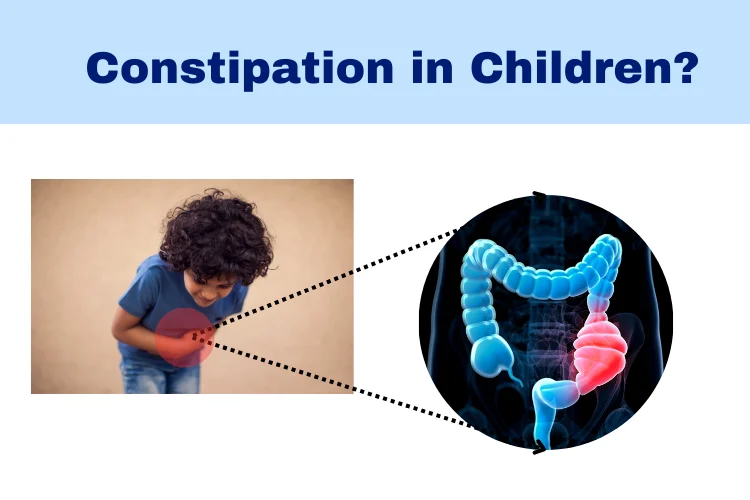Constipation in children is a common issue that involves difficulty passing hard, dry stools, often causing discomfort or pain. While many assume it’s just about infrequent bowel movements, it’s more about the stool’s consistency and the ease with which it passes. A healthy diet, hydration, physical activity, and proper toilet habits are essential in preventing and managing constipation. In infants, medical advice is especially important for safe and effective treatment.
Common Causes of Constipation in Children
Constipation in children is not simply defined by how often they use the toilet. A child might go only once or twice a week and still not be constipated if their bowel movements are soft and passed without discomfort. On the other hand, if the stool is hard, dry, and painful to pass, the child is considered constipated—even if they go frequently.
In babies, signs of constipation include pellet-like or crumbly stools. They may also show signs of discomfort or bloating. Chronic constipation can lead to complications like soiling, where softer stool leaks out around a hard mass of feces, potentially causing embarrassment and hygiene issues.
What Is Constipation in Children?
While the causes can vary, some common factors include:
- Low fiber intake: Children consuming too much milk and not enough solid or fibrous foods are at greater risk.
- Painful past experiences: A tear near the anus (anal fissure) from a hard stool can make children reluctant to go to the toilet.
- Ignoring the urge: Some children resist using the toilet due to distractions (like play) or discomfort with public or school bathrooms.
- Toilet training issues: Anxiety or pressure during toilet training can lead to stool withholding.
- Lack of physical activity: Inactivity slows down the digestive system.
Recognizing the Symptoms of Constipation in Children
Watch out for these warning signs:
- Complaints of pain during bowel movements
- Visible straining or body language indicating they are “holding it in” (e.g., leg crossing, crying, fidgeting)
- Abdominal pain or bloating
- Soiling of underwear, especially if it becomes a recurring issue
How to Treat Constipation in Children Naturally
Lifestyle and Behavioral Strategies
- Increase physical activity: Encourage regular exercise to stimulate bowel movements.
- Establish a daily toilet routine: Set a consistent time each day for your child to sit on the toilet, ideally after meals. Using positive reinforcement, such as a reward chart, can help build the habit.
- Address school toilet concerns: If your child is uncomfortable using school toilets, speak with staff to ensure access to a clean, private, and safe bathroom.
- Monitor laxative use: Avoid frequent or long-term use unless prescribed by a doctor. Bulk-forming laxatives may be used temporarily, but the underlying behavior or diet should be addressed.
Early intervention is key. The longer constipation goes untreated, the more difficult it may be to resolve.
ALSO VISIT
Dietary Changes: Adding More Fiber
Nutrition plays a vital role in preventing and relieving constipation. Here are some tips:
- Choose high-fiber foods: Offer wholegrain breads, cereals, brown rice, and wholemeal pasta.
- Incorporate fruits and vegetables: Fresh and dried fruits (like prunes, pears, and apricots) can be particularly helpful.
- Promote hydration: Ensure your child drinks plenty of water throughout the day.
Introduce fiber gradually to avoid bloating or gas.
Constipation in Infants: Special Considerations
Constipation in babies, especially those who are breastfed, is rare. Breastfed infants may go several days without a bowel movement, but their stools are usually still soft. True constipation in infants should always be evaluated by a healthcare professional.
Managing Constipation in Babies
- Improper formula preparation: Too much formula powder relative to water can make stools harder.
- Switching formulas: Some babies react to a change in formula or transitioning to cow’s milk.
- Insufficient fluid intake: Especially in warm climates, babies may need additional fluids such as cooled, boiled water (for bottle-fed babies).
- Inappropriate solids: Introducing solids that are not age-appropriate or too high in fiber can lead to constipation.
- Pain from hard stools: A hard stool can cause tiny tears in the anal area, leading to pain and stool withholding, worsening the condition.
Managing Constipation in Infants
If your baby is showing signs of constipation, here are some strategies:
- Check formula preparation: Always mix formula according to the instructions—measure the water first before adding the powder.
- Offer extra fluids: Provide small amounts of cooled, boiled water between feeds if recommended.
- Tummy massage and warm baths: Gently massaging your baby’s tummy or bathing them in warm water may help relax their muscles and ease bowel movements.
- Follow professional advice: Only give medications or treatments recommended by your doctor.
What NOT to Do When a Baby is Constipated
Avoid these common but harmful practices:
- Don’t give prune juice to infants under six months: It contains natural compounds that may irritate a young baby’s gut.
- Don’t add sugar or rice cereal to formula: These won’t help and can be harmful.
- Don’t introduce solids too early: Solids should not be introduced before 4–6 months as a solution for constipation.
Long-Term Effects of Chronic Constipation Causes, Symptoms, and Effective Treatments
While occasional constipation is typically harmless, long-standing issues can lead to significant problems, such as:
- Fecal impaction: A buildup of hard stool in the bowel
- Soiling accidents: Due to leakage of soft stool around a hard mass
- Emotional and social stress: Especially for school-aged children who may feel embarrassed
If constipation becomes chronic or severe, medical intervention is necessary to prevent lasting physical and psychological impacts.
When to Seek Help Constipation in Children
If your child’s constipation persists despite dietary and lifestyle changes, or if they experience pain, blood in stools, or frequent soiling, consult your doctor or child health nurse for further evaluation and treatment.
